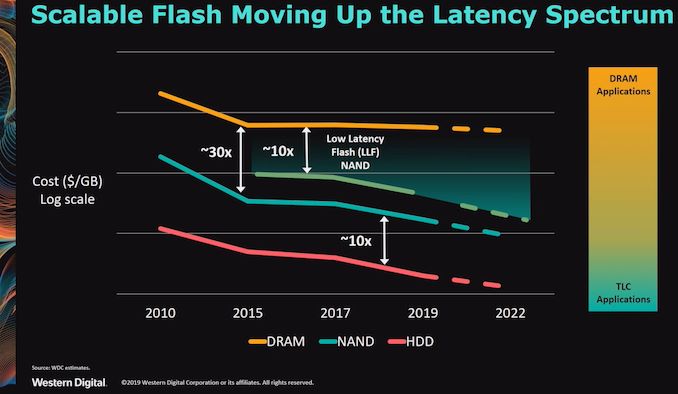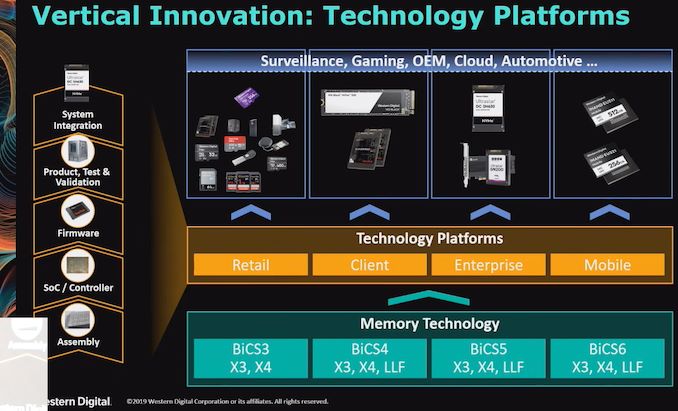Western Digital Develops Low-Latency Flash to Compete with Intel Optane
by Anton Shilov on March 12, 2019 12:00 PM EST
Western Digital is working on its own low-latency flash memory that will offer a higher performance and endurance when compared to conventional 3D NAND, ultimately designed to compete against Optane storage.
At Storage Field Day this week, Western Digital spoke about its new Low Latency Flash NAND. The technology is meant to fit somewhere between 3D NAND and DRAM, similar to Intel's Optane storage and Samsung's Z-NAND. Similar to those technologies, according to Western Digital, its LLF memory will feature access time “in the microsecond range”, using 1 bit-per-cell and 2 bit-per-cell architectures.
The manufacturer admits that its LLF is a customized device that is very fast because it is tailored for performance. The memory will cost 10 times less than DRAM, but 20 times more than 3D NAND (at least based on today’s estimates) in terms of per-GB prices, so it will likely be used only by select applications aimed at datacenters or high-end workstations, similar to where Optane and Z-NAND is today.
Western Digital does not disclose all the details regarding its low-latency flash memory and it is impossible to say whether it has anything to do with Toshiba’s XL-Flash low-latency 3D NAND introduced last year as well as other specialized types of flash. Quite naturally, the company is also reluctant to talk about actual products based on its LLF memory, or when are they set to become available. Meanwhile, Western Digital’s LLF belongs to the BICS4 generation of 3D NAND memory and can therefore be produced even today.
While Western Digital’s low-latency flash will compete against Intel’s Optane and Samsung’s Z-NAND SSDs, the company does not call LLF as a Storage Class Memory (SCM).
In the more long term, Western Digital is working on ReRAM-based SCM internally, and on memristor-based SCM with HP. Keeping in mind that research and development cycles take many years, it looks like the company will address applications that require capacity and performance with a more familiar NAND flash before adopting next-gen technologies.
Related Reading
- Toshiba Announces XL-Flash Low-Latency 3D NAND
- Western Digital to Use 3D ReRAM as Storage Class Memory for Special-Purpose SSDs
- Microsemi Licenses Crossbar ReRAM Non-Volatile Memory
- New Generation of Optane M.2 SSDs Coming Soon
- Intel's Response: Micron’s Control of 3D XPoint Fab Will Not Disrupt Optane Roadmap
Source: Western Digital at Storage Field Day (via Blocks & Files)













22 Comments
View All Comments
PeachNCream - Thursday, March 14, 2019 - link
Do they need to hit 88 mph to do that?jchang6 - Tuesday, March 12, 2019 - link
It should be possible with firmware to operate the standard TLC NAND as MLC or SLC. This would result in 3X increase in cost per bit at SLC and have improved latency performance. But for really great performance, we would like a custom NAND with smaller page size, perhaps 1-2KB, versus the standard 16KBMrSpadge - Wednesday, March 13, 2019 - link
You are describing Samsungs Z-NAND ;)coburn_c - Tuesday, March 12, 2019 - link
Great so... another proprietary tech that won't see proper [driver] support or adoption and will never see competitive pricing due to ... propriety.coburn_c - Tuesday, March 12, 2019 - link
To further my indifference: xkcd has a comic about standards.... to which to WDC contributes: There are 14 competing standards, let's make our own.KarlKastor - Thursday, March 14, 2019 - link
This is not a new standard, it's an new technology. No company shares technology, that's what they make money with.They will use the same NVMe Standard as other Flashdrive manufacturers.
Don't see your problems.
MrSpadge - Wednesday, March 13, 2019 - link
It won't need driver support per se, just a suitable controller. Software wise anything built for Optane, Z-NAND etc. should equally work with this.Khenglish - Tuesday, March 12, 2019 - link
Why don't flash makers just make NOR memory if they want more speed? Or is that what this actually is?NOR memory should be several times faster than NAND while having roughly half the density, at least according to my quick mental math.
flgt - Tuesday, March 12, 2019 - link
I don’t think that NOR write times are spectacular. It’s not going to get you to the holy grail of non-volatile memory that has the speed of DRAM and the cost and scaling of NAND. Optane is the only thing remotely close. MRAM, ReRAM are still niche and don’t seem to be scaling economically.Khenglish - Wednesday, March 13, 2019 - link
Yeah NOR writes are still in blocks like NAND. Reads are much much faster and simpler though. You read more often than you write too. This isn't necessarily about beating optane in speed, but about offering better performance per dollar at similar storage sizes.I just feel like with what WDC just announced here with a higher performance, higher cost NAND, that they could have done better on both the speed and cost by just doing NOR.
Doing NOR probably is quite a bit of redesign work though. You are playing around with your most fundamental storage structures. If you mess it up and all your drives have an issue that is a lot of product recalls. WDC seems to have taken a safer route.